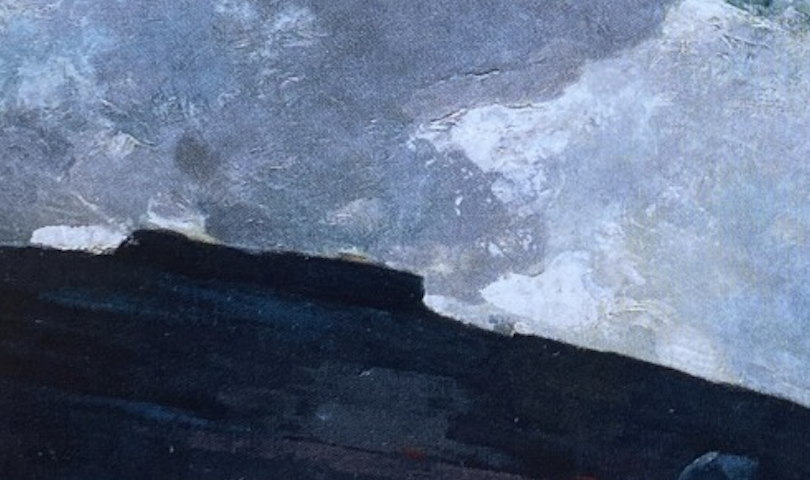An extract from the forthcoming programme notes for A Sea Symphony...
Ralph Vaughan Williams (1872-1958): A Sea Symphony (Symphony No. 1) (1903-9, revised 1918)
1 A Song for All Seas. All Ships (Andante maestoso)
2 On the Beach at Night Alone (Largo sostenuto)
3 Scherzo – The Waves (Allegro brillante)
4 The Explorers (Grave e molto adagio)
“The plan of the work is symphonic rather than narrative or dramatic…The words as well as the music are treated symphonically…the orchestra has an equal share with the chorus and soloists in carrying out the musical ideas.” (Vaughan Williams’s Programme Note for the first London performance, February, 1913.)
Despite this claim, A Sea Symphony does not obviously conform to conventional symphonic structure. Its innovative hybrid character, combining orchestral symphonic elements equally with those of the choral genres of oratorio and cantata, differentiates it clearly from earlier symphonies with voices. Yet the contrasting complexities of the momentous opening and closing movements, despite their sometimes-episodic characters, sustain a strong thematic momentum. This is developed imaginatively and variously in the movements between them in ways that surely justify Vaughan Williams’s claim as an account of its form, rather than simply a description of its plan.
It was his most ambitious work and had taken more than six years to complete. By the time he conducted its first performance at the 1910 Leeds Festival on his 38th birthday, Vaughan Williams was recognised as a significant composer with a strong reputation, but his work during the years from 1908 to 1911 transformed his status into that of a major figure. He returned from Paris in February, 1908 after 3 months studying orchestration with Maurice Ravel in order, he had said at the time, to give his composing skills ‘a bit of French polish’, later admitting that what he had really learnt from Ravel was ‘how to orchestrate in colour rather than in lines’, what Ravel himself characterised as ‘building an atmosphere of sound around the written notes’ – a quality well-displayed in the almost pictorial representations of sea and ships in the symphony Vaughan Williams was able finally to complete over the following months. During the same period, he composed two other works – Fantasia on English Folk Song and Fantasia on a Theme by Thomas Tallis – which were also premiered in 1910, as well as beginning work on his first opera. This was an annus mirabilis, at the centre of an intensely creative period during which A Sea Symphony was the core work.
Many poems of Walt Whitman (1819-92) lend themselves to musical settings. He referred to his verses as songs and chants, insisting to one of his biographers that ‘during the gestation of the poems, the author was saturated for years with the rendering, by the best vocalists and performers, of the best operas and oratorios’. By 1855 he had found his distinctive voice, publishing twelve free verse poems as the first edition of Leaves of Grass, with a lengthy preface proposing his universalising project for poetry as ontology, epistemology and politics. His unshakeable self-confidence as the architect of the project is evident in the opening lines of ‘Song of Myself’, the first poem in the collection: ‘I celebrate myself/And what I assume you shall assume, /For every atom belonging to me as good belongs to you.’ In the last edition, of more than 400 poems assembled by Whitman himself, he was ‘determined to have the world know what I was pleased to do’. This was invariably conceived on a grand scale, often lengthy and with a sense both of and for occasions. D. H. Lawrence, who felt he owed Whitman a considerable debt in finding his own poetic voice, was critical nevertheless of his ‘stridency and portentousness…A luridness about his beatitudes…All that false exuberance…Walt becomes in his own person the whole world, the whole universe, the whole eternity of time…He was everything and everything was in him’. Yet Lawrence thought him nevertheless ‘a very great poet, of the end of life…Ahead of all poets, pioneering into the wilderness of unopened life’.
Vaughan Williams was introduced to Whitman’s work by Bertrand Russell, when both were students at Cambridge in the 1890’s. Like many of their contemporaries, they would have seen his work as expressing the spirit of a new age at the turn of the century. Ursula Vaughan Williams notes that from the early 1900’s ‘Walt Whitman’s Leaves of Grass…was his constant companion…and the idea of a big choral work about the sea-the sea itself and the sea of time, infinity, and mankind-was beginning to take shape’. He had already set Whitman’s verse in 1907 for his mystical choral orchestral piece, Towards the Unknown Region and then the Three Nocturnes of 1908, but it was in his selection of texts to set for A Sea Symphony that he demonstrates the depth and familiarity of his knowledge of and commitment to it. His earlier settings of Whitman’s work demonstrated how to take advantage of the opportunities provided by free verse’s indulgence in the intrinsic rhythms of verbal language, matching it with musical rhythms to create works of art greater than the sum of their parts.
The couplet: ‘Behold, the sea itself/And on its limitless, heaving breast, the ships’; which opens and closes the text of the first movement of the symphony is taken from ‘Song of the Exposition’, composed by Whitman for an exhibition in New York in 1871, ‘to outline the establishment of a great Cluster-Palace of Industry from an imaginative and Democratic point of view’. The substantive text, however, is from a poem with the same title: ‘A Song for All Seas, All Ships’, commemorating the loss of 800 people drowned in two steamships which sank during 1873.
Musically the opening, marked Andante Maestoso, is a huge brass fanfare in B-flat minor for trumpets and horns preceding the choir’s unaccompanied, declaratory imperative ‘Behold, the’, followed by a timpani-led brillante orchestral accompaniment in the celebratory key of D-major to ‘sea itself’. In his programme note for the first London performance, Vaughan Williams identified this chord sequence as the first of ‘the two main musical themes which run through the four movements’. The second is the melody that follows it immediately to accompany ‘and on its limitless, heaving breast, the ships’. Appropriately following sonata-like form, these dramatic expository opening passages are elaborated as a panoramic display of the lively business-like activities of ships of all types working at sea – ‘coming and going, steaming in and out of port’ – and developed further by the soloists. The baritone introduces an allegro to shanty rhythms as ‘a brief rude recitative’ encompassing the separate flags or signals of each ship, the ‘un-named heroes’ who sail them over ‘waves spreading far as the eye can reach’ their ‘dashing spray’ whipped up by ‘winds piping and blowing’. He leads the choir into a solemn, lyrical chant for ‘all intrepid sailors whom fate can never surprise nor death dismay’. They are ‘indomitable, untamed’ as the sea itself, which ‘unitest the nations’; the ‘old husky nurse’ that has ‘picked sparingly without noise…chosen and suckled’ them to embody her.
It is at this point that Vaughan Williams begins his own engagement with Whitman’s metaphysical project in a metaphorical universalising of both sailors and seas. The soprano soloist, echoed by the chorus, enters with the command to ‘Flaunt out O sea your separate flags of nations!’ instructing the now anthropomorphised sea to ‘reserve especially for yourself and for the soul of man one flag above all the rest,/A spiritual woven signal for all nations, emblem of man elate above death’. The intensity of the orchestral accompaniment to this announcement emphasises its importance in bringing into focus ‘the soul of man’ as the centre of Vaughan Williams’s engagement with Whitman’s project, punctuating the passage with a succession of emphatic choral iterations of ‘above death’.
Unaccompanied, the soprano soloist announces that this flag is to be ‘Token of all brave captains and of all intrepid sailors and mates/And all that went down doing their duty’. Followed at first by female voices, then the full chorus, she leads an unfolding of the movement, first as a lament for those sailors lost at sea, then to a resolution as the baritone and chorus return to further universalise the flag-token as ‘A pennant universal, subtly waving all time, o’er all brave sailors,/All seas, all ships’. The movement closes with the chorus softly repeating ‘All seas, all ships’ as the opening injunction to ‘Behold, the sea itself…’ is recalled quietly…
…An extract from the programme notes for A Sea Symphony
Paul Filmer, April 2023


